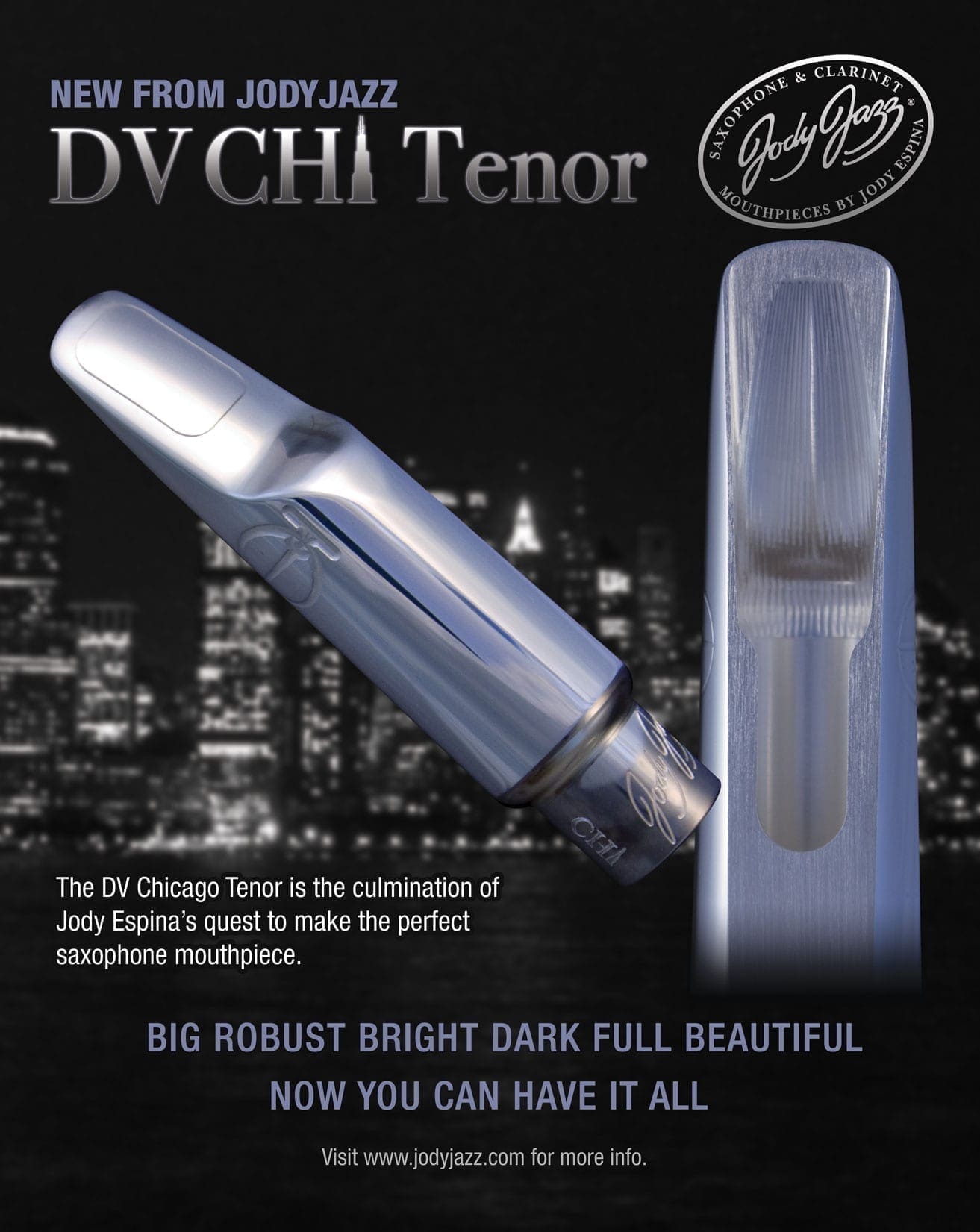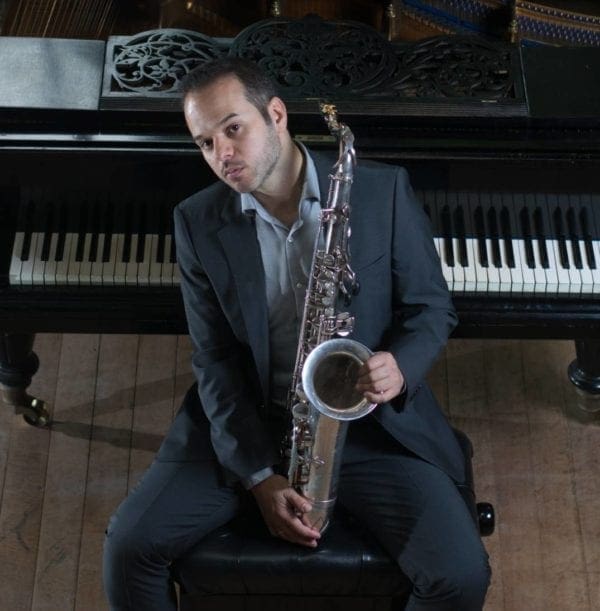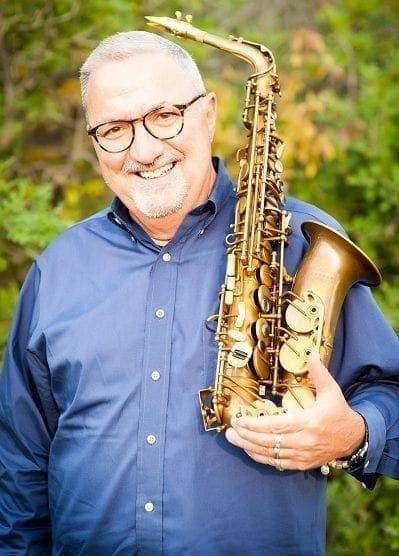Big Robust Sound
JodyJazz DV CHI Tenor
Palladium-plated Metal Tenor Saxophone Mouthpiece
U.S. Patent No. 7,470,844
$675.00
Palladium-plated Metal Tenor Saxophone Mouthpiece
U.S. Patent No. 7,470,844
$675.00
The DV Chicago model Palladium-plated metal tenor saxophone mouthpiece is the culmination of a quest by Jody Espina to make the most efficient saxophone mouthpiece that delivers the biggest, fullest sound.
The DV CHI produces a darker, less bright tone than the contemporary sound of the JodyJazz DV, but a considerably brighter more modern tone than the JodyJazz DV NY. The beautifully shaped baffle/chamber design of the DV CHI produces a tone that is reminiscent of Dexter Gordon but is quite at home in a contemporary situation.
Simply put, the DV CHI combines the best properties of the highly successful DV and DV NY series while adding several new design modifications which enhance the players ability to manipulate the tone. The scalloped chamber also allows the player to push more air through the mouthpiece without experiencing any harshness.
Here, nature, science and imagination combine to create a revolutionary new saxophone mouthpiece. Jody Espina has designed the patented JodyJazz CHI, using proportions and principles found in nature. For a powerful, husky, effortless playing experience, we invite you to try the DV CHI.
DV CHI is a Palladium-plated metal tenor saxophone mouthpiece. The mouthpiece comes with a Silver finish H-Ligature, Cap and Deluxe Mouthpiece Pouch and Metal Canister. Free domestic USPS Priority Mail shipping and handling included. (See Overseas Shipping below for prices)
$675.00
CLICK HERE to compare JodyJazz mouthpieces with other brands.


“For years I was looking for a mouthpiece that would help me to get closer to the sound of two of my favorite players of all times, Dexter Gordon and Johnny Griffin. My JodyJazz DV Chicago 8* not only does that but also allows me to use the full depth of my tone whether it’s a jazz ballad or an up-tempo tune.” “I’ve been using exclusively hard rubber mouthpieces on alto for years till I tried the JodyJazz DV Alto 7. I was really impressed as it has got all the qualities I’m looking on a mouthpiece. It combines great projection as well as the right warmth that I want my tone to have when I play jazz and on top of that just the right amount of resistance that helps with jazz phrasing.”

“Jody’s mouthpieces are so free blowing and consistent. I have not seen quality control like this in any other mouthpiece company. These mouthpieces allow me to sound like I want, with the versatility to adjust my sound to the musical situation. Jody truly has a mouthpiece for every player!”

“… the DV CHI has the most effortless playability of any mouthpiece I’ve ever encountered … the […]
“DV CHI produces a robust well-rounded sound… broader tonal spectrum…effortless response.”
“… the DV CHI has the most effortless playability of any mouthpiece I’ve ever encountered … the […]


New Facing Technology and Curve – We have invested in new CNC technology and have come up with a proprietary way of putting on a new facing curve, which is perfect every time.
Due to the free blowing nature of the DV CHI Tenor, be prepared to use a harder reed than you normally do. This may or may not be the case for you. The great benefit of this is that a harder reed lasts longer and a harder reed helps the altissimo range. For this same reason, you may want to try a slightly more open tip than normal. For example, Otto Link # 7 players, will usually play a DV CHI 7*.

Almost all metal mouthpieces in the past and at the present time are made out of brass which can contain up to 3% lead. The lead in the brass is one of the components that give this particular brass it ’s hardness or rather it’s softness which makes it have a particularly pleasing sound to musicians. Proposition 65 from the state of California requires manufactures to label any products that have compounds in them that have been found to cause Cancer or Reproductive Harm. Lead is one of these Compounds. JodyJazz mouthpieces are electroplated with a layer of copper, then a layer of Nickel, Silver or Rhodium, and then a layer of Gold or Silver. This electroplating ensures that the raw brass is never in contact with the player.
This is Jody Espina and yes myself and my employees have been using JodyJazz Gold or Silver Plated brass mouthpieces for many years. My first JodyJazz brass mouthpiece was made in 2001 and I have continuously been playing JodyJazz brass mouthpieces since. I played my first metal mouthpiece in 1979 on tenor sax and have always used a brass mouthpiece on tenor sax ever since then.
Yes. Ben Webster, Coleman Hawkins Stan Getz, Sonny Rollins, Dexter Gordon, John Coltrane, Michael Brecker, Tom Scott Andy Snitzer are just a few of the 1000’s and 1000’s of players who have played brass mouthpieces.
Palladium is one of the earth’s most durable elements. It is a member of a group of precious hard metals that also includes Platinum but is actually rarer than Platinum and considerably more expensive. Palladium is intrinsically harder than standard Sterling Silver, is highly resistant to corrosion, and will not tarnish in air. Because of these properties, Palladium is increasingly used as an alternative to Silver-plating and today is widely found in everything from high-end automobiles to expensive jewelry, and now saxophone mouthpieces.